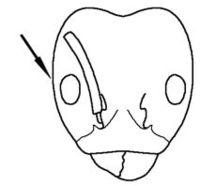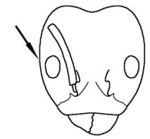Key to the Dolichoderinae genera of the southwestern Australian Botanical Province
This key to workers is based on: Heterick, B. E. 2009a. A guide to the ants of South-western Australia. Records of the Western Australian Museum, Supplement 76: 1-206. Part 1.
You may also be interested in
1
- Petiole without a distinct node (Figure 32); posterior margin of clypeus a broad, even arc (Figures 184, 185) . . . . . 2
- Petiole with a distinct node (Figure 34), or, if node weakly indicated (Figure 33), posterior margin of clypeus elliptical or forming a shallow rectangle, with medial sector often more-or-less straight (Figures 133b, 134b) . . . . . 3
2
return to couplet #1
- Gaster with five plates (tergites) on its upper surface (Figure 32); pronotum generally with erect setae; larger (≈ 3 mm); black . . . . . Technomyrmex (There is a single species present: Technomyrmex jocosus)
- Gaster with four plates on its upper surface (as in Figure 33); pronotum without setae in WA spp.; smaller (1–1.5 mm); brown or yellowish . . . . . Tapinoma
3
return to couplet #1
- Propodeal angles produced as distinct spines on the same plane as the mesosoma (Figure 35); ant red-and-black . . . . . Froggattella
- Propodeal angles usually not produced as spines (eg. Figures 36, 37), if spines present then not on same plane as the mesosoma and ant with black body . . . . . 4
4
return to couplet #3
- Underside of head near mandibular insertion with a weak to well developed flange (Figures 38a); head and mesosoma usually strongly sculptured; propodeum often concave (Figure 38b) or propodeal angle produced as spines) (Figure 38c) . . . . . Dolichoderus
- Underside of head near mandibular insertion rounded or with a ridge, but never with a flange (Figure 39); head and mesosoma at most with very weak shagreenate sculpture; propodeum usually rounded, may be concave but never with spines . . . . . 5
5
return to couplet #4
- Palps very short (PF 2,2) (Figure 40); eyes small (about 50 facets); clypeus with several to many downwardly curved setae which are about the same length as the closed mandibles . . . . . Arnoldius (formerly Bothriomyrmex)
- Palps longer (PF 6,4 or 5,3) (see Figure 39); eyes generally larger (50 facets >); clypeus (except Nebothriomyrmex) with several to many short, occasionally curved setae, which are much shorter than the closed mandibles . . . . . 6
6
return to couplet #5
- Declivitous face of propodeum concave (Figure 41); head and mesosoma usually dull black, gaster often shiny with purple or blue iridescence, very rarely with red head and mesosoma, black gaster; nearly always associated with wood or man-made structures . . . . . Ochetellus
- Declivitous face of propodeum never concave, propodeum usually rounded, occasionally flattened or square (Figures 42, 43); often brown, black or bicoloured, appearance rarely as above; most species ground nesting . . . . . 7
7
return to couplet #6
- Mesosoma consisting of three compact segments, the two thoracic segments higher than long with the propodeum often obliquely flattened; petiolar node a small to minute scale, sometimes barely visible (ant very Tapinoma like) (Figure 37); small to minute species (≈ 1–1.5 mm) . . . . . 8
- Mesosoma not so compact, the propodeum in particular broader, at least as high as long, and generally rounded or square; petiolar node more robust (see Figures 42, 43); most species of at least medium size (2–5 mm) . . . . . 9
8
return to couplet #7
- Pronotum rising abruptly at approximately 90° to form a small protuberance (Figure 44); eyes small (≈ greatest width of antennal scape) . . . . . Nebothriomyrmex (There is a single species present: Nebothriomyrmex majeri)
- Pronotum moderately to strongly convex but not rising abruptly to form a protuberance (Figure 45); eyes large (2 × greatest width of antennal scape ≥) . . . . . Doleromyrma
9
return to couplet #7
- Palps shorter (PF 5,3); propodeum square in shape, sometimes with small lip anteriad (Figure 43); odour of fresh specimens aromatic (like perfume); colony often covers its nests and trails with frass (plant fibres, chewed up wood fragments and faeces) . . . . . Papyrius
- Palps longer (PF 6,4); propodeum at least gently rounded (Figure 42); fresh specimens either without odour or with strong acrid or chemical odour, rarely that of perfume; colonies do not use frass . . . . . 10
10
return to couplet #9
- Anterior margin of clypeus with central protuberance (lacking in one black, iridescent species with a low broad node and propodeal spiracles placed at the propodeal angles); eyes placed rather high on sides of head capsule (about the mid-point) (Figure 46) . . . . . Iridomyrmex
- Anterior margin of clypeus without a central protuberance, either broadly convex, straight or broadly concave; eyes placed below mid-point of head capsule (Figures 47, 48) . . . . . 11
11
return to couplet #10
- Outline of mesosoma smooth except for gently rounded propodeum (Figure 49); widest point of head capsule above eye; posterior margin of head capsule slightly concave or straight (Figure 47); brown ants; little or no odour; exotic tramp species found mostly in highly disturbed environments . . . . . Linepithema (There is a single species present: Linepithema humile)
- Outline sinuate (strongly rounded propodeum and usually also mesonotum) (Figure 50); widest point of head capsule near eye; posterior margin of head capsule moderately to strongly concave (Figure 48); black ants; strong chemical odour; native species found in woodland . . . . . Anonychomyrma
































